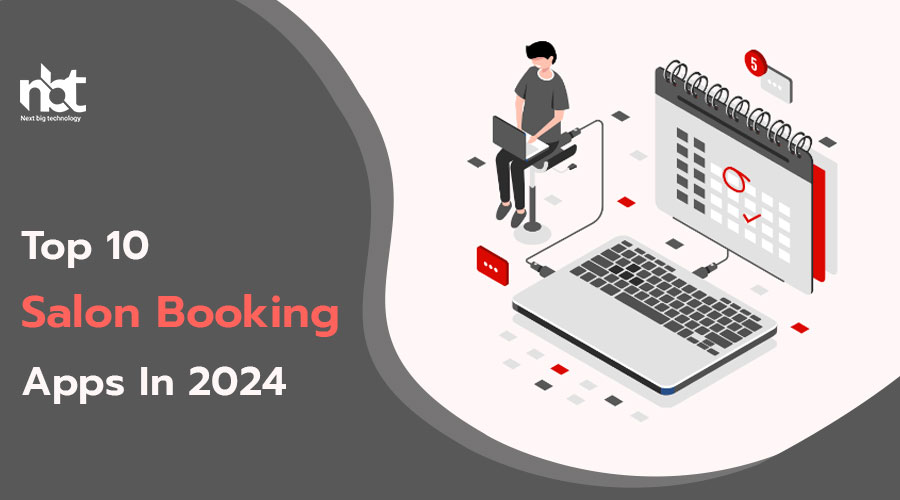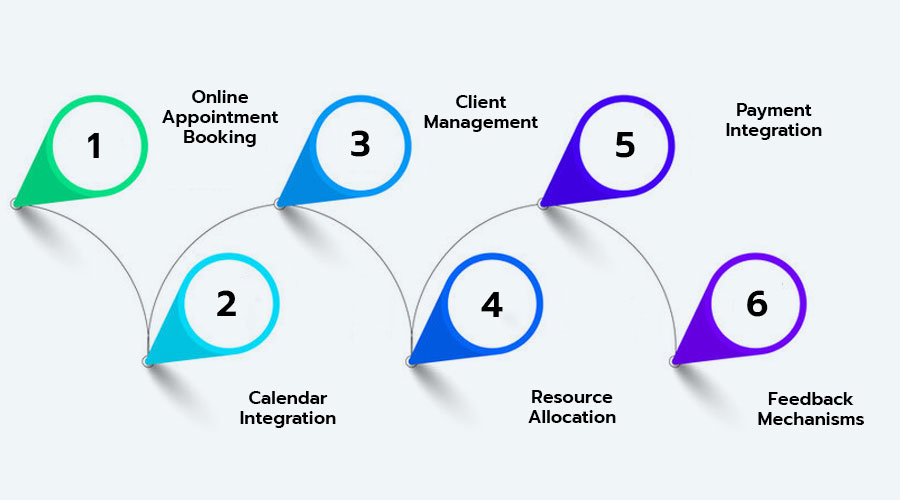Table of Contents
Introduction to Salon Booking Apps
In today’s fast-paced world, convenience is key, and nowhere is this more evident than in the beauty industry. Whether you’re a salon owner or a client seeking the perfect pampering session, the emergence of salon booking apps has revolutionized the way we approach beauty appointments. These innovative tools bring efficiency, organization, and seamless communication to both sides of the salon chair. Let’s delve into the world of salon booking apps and explore how they’re transforming the beauty landscape.
Simplifying Scheduling: Gone are the days of endless phone calls and back-and-forth emails to schedule a salon appointment. With salon booking apps, clients can easily browse available time slots and book appointments with just a few taps on their smartphones. This convenience eliminates the need for lengthy booking processes and allows clients to secure their desired services at their convenience.
Seamless Communication: Communication is key in any service industry, and salon booking apps facilitate smooth interaction between clients and salon staff. From confirming appointments to sending reminders and updates, these apps keep everyone in the loop and minimize the risk of misunderstandings or missed appointments. Clients can communicate their preferences or special requests directly through the app, ensuring that their salon experience is tailored to their needs.
Personalized Experience: Salon booking apps often come with features that enhance the overall customer experience. Clients can create profiles where they can store their preferences, previous services, and even payment information for seamless transactions. This personalized approach allows salon staff to provide tailored recommendations and services based on each client’s unique preferences and history, fostering a sense of loyalty and satisfaction.
Streamlined Operations: For salon owners and staff, booking apps offer a host of benefits beyond just scheduling appointments. These apps often include features for managing staff schedules, tracking inventory, and analyzing business performance. By automating administrative tasks and providing valuable insights into salon operations, booking apps empower salon owners to focus on delivering exceptional service and growing their businesses.
Enhanced Accessibility: In today’s digital age, accessibility is paramount, and salon booking apps make it easier than ever for clients to connect with their favorite salons. Whether they’re at home, on the go, or traveling abroad, clients can access salon services and book appointments with ease. This level of accessibility not only expands the reach of salon businesses but also ensures that clients can enjoy a seamless beauty experience wherever they are.
Criteria for Evaluating Salon Booking Apps
In today’s fast-paced world, where convenience is key, salon booking apps have become indispensable tools for both salon owners and customers alike. With an array of options flooding the market, it can be challenging to discern which app best suits your needs. Fear not, as we delve into the essential criteria for evaluating salon booking apps, empowering you to make informed choices tailored to your preferences.
- User Interface (UI) and Experience (UX): The first impression is crucial, and a user-friendly interface sets the tone for a seamless experience. Evaluate how intuitive the app is to navigate, ensuring that both salon owners and clients can effortlessly browse services, select preferred timings, and make bookings without any hiccups.
- Booking Management Features: A robust booking management system is the backbone of any salon booking app. Look for features such as real-time availability updates, automated reminders, and easy rescheduling options. Additionally, the ability to manage multiple bookings simultaneously and integrate with the salon’s calendar system enhances operational efficiency.
- Customization and Branding: Every salon has its unique branding and service offerings. A top-tier booking app should allow for customization, enabling salons to personalize their profiles with logos, brand colors, and service descriptions. This not only fosters brand consistency but also helps attract clientele aligned with the salon’s aesthetic.
- Payment Integration and Security: Seamless payment processing is essential for a hassle-free booking experience. Evaluate the app’s payment integration capabilities, ensuring support for multiple payment gateways and secure transactions. SSL encryption and compliance with industry standards safeguard sensitive financial information, instilling trust among users.
- Client Management and Engagement Tools: Beyond booking appointments, a comprehensive salon booking app should offer features for client management and engagement. Look for functionalities like customer profiles, appointment histories, and loyalty programs. Moreover, integration with communication channels such as SMS and email facilitates personalized outreach and promotions.
- Analytics and Reporting: Data-driven insights empower salon owners to optimize their operations and marketing strategies. Analyze the app’s reporting capabilities, including key metrics such as booking trends, revenue generation, and client demographics. Access to actionable analytics enables informed decision-making and drives business growth.
- Mobile Compatibility and Accessibility: With mobile usage on the rise, compatibility across various devices is paramount. Ensure that the app is available on both iOS and Android platforms, catering to a broader audience base. Additionally, responsive design and offline functionality ensure uninterrupted access, even in areas with poor connectivity.
- Customer Support and Reliability: In the event of technical issues or inquiries, responsive customer support can make all the difference. Evaluate the app provider’s support channels, including live chat, email, and phone support. Furthermore, assess the app’s reliability in terms of uptime, bug fixes, and regular updates to ensure a smooth user experience.
App Security and Privacy Features
In today’s digital age, where our lives are intertwined with technology, ensuring the security and privacy of our personal data has become paramount. With the proliferation of mobile applications, users are often faced with concerns regarding the safety of their information. This has led to a growing demand for robust app security and privacy features that offer peace of mind to users.
Understanding the Importance
App security and privacy features play a crucial role in safeguarding sensitive information from unauthorized access, data breaches, and other potential threats. Whether it’s personal details, financial transactions, or confidential communications, users entrust apps with a wealth of data, making it imperative for developers to prioritize security and privacy measures.
Key Security Features
- End-to-End Encryption: Implementing end-to-end encryption ensures that data is encrypted on the sender’s device and decrypted only on the recipient’s device. This means that even if intercepted, the data remains unreadable to unauthorized parties, providing a secure communication channel.
- Two-Factor Authentication (2FA): 2FA adds an extra layer of security by requiring users to provide two forms of identification before accessing an account or performing sensitive actions. This significantly reduces the risk of unauthorized access, even if login credentials are compromised.
- Regular Security Updates: Developers should prioritize releasing regular security updates to patch vulnerabilities and address emerging threats promptly. Keeping the app’s security measures up-to-date is essential in maintaining its resilience against potential attacks.
Crucial Privacy Features
- Privacy Policy: Every app should have a clear and concise privacy policy that outlines how user data is collected, used, and protected. This transparency fosters trust among users and allows them to make informed decisions regarding their privacy.
- Data Minimization: Adopting a data minimization approach involves collecting only the necessary information required for the app’s functionality. This reduces the amount of sensitive data stored, minimizing the potential impact of a data breach.
- User Consent: Apps should obtain explicit consent from users before collecting any personal information. This ensures that users have control over their data and are aware of how it will be utilized by the app.
User Interface and Experience Comparison
In the dynamic world of digital design, two crucial elements stand out as pillars shaping the success of any software or application: User Interface (UI) and User Experience (UX). While often used interchangeably, UI and UX are distinct components that contribute uniquely to the overall functionality and appeal of a product. Understanding the disparity between them is key to crafting a seamless and engaging digital experience for users.
User Interface (UI): The Visually Striking Facade
UI refers to the visual elements of a digital interface with which users interact. It encompasses everything from buttons and icons to color schemes and typography. Think of it as the cosmetic layer of a product, responsible for its aesthetic appeal and overall look. A well-designed UI is not only visually pleasing but also intuitive, making navigation effortless for users.
The primary goal of UI design is to create a visually appealing layout that facilitates smooth interaction. This involves careful consideration of factors such as:
- Consistency: Maintaining uniformity in design elements across the interface ensures coherence and reduces cognitive load for users.
- Clarity: Clear and concise visuals help users understand the purpose and functionality of each element without ambiguity.
- Accessibility: Designing with accessibility in mind ensures that users with disabilities can navigate the interface effectively.
By focusing on these principles, UI designers strive to create interfaces that captivate users from the moment they interact with the product.
User Experience (UX): The Seamless Journey
UX, on the other hand, encompasses the entirety of the user’s interaction with a product. It delves deeper into the emotional and psychological aspects of user engagement, aiming to provide a seamless and enjoyable journey from start to finish. While UI focuses on the surface-level aesthetics, UX delves into the functionality and usability of the interface.
UX design involves understanding the needs and preferences of the target audience and crafting a journey that meets those requirements. Key considerations in UX design include:
- User Research: Conducting thorough research to gain insights into user behaviors, preferences, and pain points.
- Wireframing and Prototyping: Creating wireframes and prototypes to test usability and gather feedback early in the design process.
- Iteration: Continuously refining the design based on user feedback to ensure optimal usability and satisfaction.
The ultimate goal of UX design is to create a cohesive and intuitive experience that leaves users feeling satisfied and fulfilled.
Understanding the Synergy
While UI and UX are distinct disciplines, they are intricately linked and complement each other in creating exceptional digital experiences. A visually stunning UI can enhance the overall appeal of a product, but without a solid UX foundation, users may struggle to navigate or understand its functionalities. Conversely, a seamless UX can elevate even a modest UI design by prioritizing user needs and optimizing usability.
In essence, UI and UX are two sides of the same coin, working in tandem to create memorable and engaging digital experiences. By prioritizing both aspects in the design process, developers can ensure that their products not only look great but also provide value and satisfaction to users.
Integration with Salon Management Software
In the fast-paced world of salon management, efficiency is key to success. From appointment scheduling to inventory management and client engagement, every aspect of your salon’s operations needs to be finely tuned for optimal performance. This is where integration with salon management software comes into play, revolutionizing the way salons operate and interact with their clients.
Salon management software serves as the backbone of modern-day salons, offering a comprehensive suite of tools designed to streamline operations and enhance the client experience. By seamlessly integrating with this software, salon owners and managers can unlock a host of benefits that can take their business to new heights.
One of the primary advantages of integrating with salon management software is streamlined appointment scheduling. With intuitive online booking systems, clients can easily schedule appointments at their convenience, reducing the need for time-consuming phone calls and manual appointment booking. Integration ensures that appointment details are automatically synced across all platforms, eliminating the risk of double bookings and scheduling conflicts.
Moreover, salon management software typically includes robust CRM (Customer Relationship Management) features, allowing salons to maintain detailed client profiles and preferences. By integrating with this CRM system, salons can personalize the client experience, offering tailored services and promotions based on individual preferences and purchase history. This not only enhances client satisfaction but also fosters long-term loyalty and repeat business.
Inventory management is another area where integration with salon management software can yield significant benefits. By automatically tracking product sales and stock levels, salons can optimize their inventory, ensuring that popular products are always in stock while minimizing excess inventory and associated costs. Integration with suppliers can further streamline the procurement process, automatically updating stock levels and facilitating seamless reordering when supplies run low.
In addition to operational efficiency, integration with salon management software can also enhance marketing efforts and drive revenue growth. Many salon management platforms offer built-in marketing tools, such as email campaigns and loyalty programs, designed to attract new clients and retain existing ones. By integrating with these marketing features, salons can leverage client data to target promotions and offers more effectively, driving foot traffic and increasing sales.
Furthermore, integration with salon management software facilitates financial management and reporting, providing salon owners with valuable insights into their business performance. By automatically tracking revenue, expenses, and other key metrics, salons can make informed decisions to optimize profitability and drive growth.
Customization and Branding Options for Salons
In the ever-evolving landscape of the beauty industry, standing out is key to success. As a salon owner or manager, you understand the importance of creating a unique and memorable experience for your clients. One way to achieve this is through customization and branding options tailored to reflect your salon’s identity and values.
Crafting Your Salon’s Identity
Before diving into customization and branding options, it’s crucial to define your salon’s identity. Consider your target audience, the atmosphere you want to create, and the services you offer. Are you a sleek urban salon catering to trendsetters, or a cozy neighborhood spot specializing in personalized pampering? Understanding your niche will guide your branding efforts.
Customizing the Client Experience
Personalization is the cornerstone of modern salon experiences. From the moment a client walks in, they should feel welcomed and valued. Simple touches like offering a choice of beverages upon arrival or remembering their preferences can go a long way in fostering client loyalty.
Investing in customizable services is another avenue to explore. Whether it’s tailored hair treatments, custom-blended skincare products, or bespoke nail art, giving clients the option to personalize their services ensures they leave feeling satisfied and special.
Branding Beyond the Basics
Branding extends far beyond logos and signage. It encompasses every interaction a client has with your salon, from booking an appointment online to post-visit follow-ups. Consistency is key here; every touchpoint should reflect your salon’s brand identity.
Consider the following branding options to elevate your salon’s presence:
- Customized Merchandise: From branded salon apparel to signature product lines, offering exclusive merchandise strengthens brand recognition and provides additional revenue streams.
- Interior Design: Your salon’s decor sets the tone for the client experience. Whether it’s sleek and modern or cozy and eclectic, ensure that your interior design reflects your brand’s personality.
- Social Media Presence: Leverage social media platforms to showcase your salon’s unique vibe. Share behind-the-scenes glimpses, client transformations, and testimonials to engage with your audience and attract new clients.
- Special Events and Promotions: Hosting themed events or seasonal promotions not only generates buzz but also reinforces your salon’s identity. Consider partnering with local businesses or influencers to reach a broader audience.
- Branded Client Communications: From appointment reminders to thank-you notes, every communication should be branded and consistent with your salon’s image.
Measuring Success
As you implement customization and branding options, it’s essential to track their impact on your salon’s success. Monitor client feedback, retention rates, and revenue growth to gauge the effectiveness of your efforts. Don’t be afraid to experiment and evolve your branding strategy based on what resonates most with your clientele.
Reviews and Ratings from Salon Owners and Clients
In the bustling world of beauty and self-care, salons stand as sanctuaries where individuals rejuvenate their spirits and enhance their appearances. Whether it’s a fresh haircut, a vibrant dye job, or a relaxing spa treatment, salon experiences often hold significant weight in people’s lives. But what truly sets a salon apart? It’s the testimonials, the feedback, and the ratings bestowed upon it by both salon owners and cherished clients alike.
The Significance of Reviews and Ratings: Reviews and ratings serve as the cornerstone of the salon industry. They not only offer valuable insights to potential clients but also provide constructive feedback to salon owners. For salon owners, these reviews are a mirror reflecting their strengths and weaknesses, guiding them towards continuous improvement. Meanwhile, for clients, they act as a compass, aiding them in making informed decisions about where to entrust their beauty needs.
Insights from Salon Owners: Salon owners, the architects behind these beauty havens, hold a unique perspective on reviews and ratings. For them, each review is a testament to their dedication and craftsmanship. Positive reviews not only validate their hard work but also serve as testimonials, attracting new clients and fostering loyalty among existing ones. Conversely, negative reviews, though sometimes disheartening, are invaluable sources of growth. They offer crucial feedback, highlighting areas for refinement and prompting necessary adjustments to elevate the salon experience.
Perspectives from Cherished Clients: On the other hand, clients wield immense power with their reviews and ratings. Their voices resonate far and wide, influencing the choices of fellow consumers. For clients, leaving a review is not merely a gesture but an opportunity to express gratitude or offer constructive criticism. A positive review can spark joy, affirming their decision to patronize a particular salon, while a negative one serves as a cautionary tale, urging others to tread carefully. In essence, client reviews are the lifeblood of salons, shaping their reputations and fostering trust within the community.
Navigating the Digital Landscape: In today’s digital age, the impact of reviews and ratings transcends physical borders. Online platforms serve as virtual storefronts, where potential clients browse through an array of salons, meticulously scrutinizing reviews before making a decision. Therefore, maintaining a pristine online reputation is paramount for salon owners. By actively engaging with reviews, addressing concerns, and showcasing a commitment to excellence, salons can solidify their standing in the competitive landscape.
Accessibility and Compatibility Across Devices
In today’s digital era, where technology evolves rapidly, ensuring accessibility and compatibility across devices has become paramount for businesses and organizations aiming to thrive in the online realm. From smartphones and tablets to laptops and desktops, users expect seamless experiences regardless of the device they use. This article delves into the importance of accessibility and compatibility and explores strategies to optimize user experience across various devices.
Understanding Accessibility and Compatibility:
Accessibility refers to the design of products, devices, services, or environments for people with disabilities. It ensures that individuals with diverse abilities can perceive, understand, navigate, and interact with digital content effectively. On the other hand, compatibility focuses on ensuring that websites and applications perform consistently across different devices, browsers, and operating systems.
Why Accessibility and Compatibility Matter:
- Inclusivity: Accessibility ensures that everyone, including people with disabilities, can access and utilize digital content without barriers. It promotes inclusivity and enables a wider audience to engage with your brand or services.
- User Experience (UX): A seamless and user-friendly experience across devices enhances customer satisfaction and loyalty. Users are more likely to engage with content that is easily accessible and compatible with their preferred devices.
- Legal Compliance: Many countries have regulations in place, such as the Americans with Disabilities Act (ADA) in the United States and the Web Content Accessibility Guidelines (WCAG), mandating accessibility standards for digital content. Non-compliance can result in legal repercussions and damage to reputation.
- SEO Benefits: Search engines prioritize websites that are accessible and user-friendly, contributing to better search rankings. By optimizing accessibility and compatibility, businesses can improve their online visibility and attract more organic traffic.
Strategies for Achieving Accessibility and Compatibility:
- Responsive Web Design: Adopting a responsive design approach ensures that websites adapt and display optimally across various screen sizes and devices. Responsive design eliminates the need for separate mobile and desktop versions, streamlining maintenance and enhancing user experience.
- Semantic HTML: Using semantic HTML markup enhances accessibility by providing clear structure and meaning to web content. Properly structured content is easier for assistive technologies, such as screen readers, to interpret, ensuring accessibility for users with disabilities.
- Alt Text for Images: Providing descriptive alt text for images enables users with visual impairments to understand the content of images through screen readers. Alt text should be concise, descriptive, and relevant to the image.
- Keyboard Accessibility: Ensure that all functionality can be operated via a keyboard alone, as some users rely on keyboard navigation instead of a mouse. Proper focus management and keyboard shortcuts enhance accessibility for users with mobility impairments.
- Cross-Browser and Cross-Platform Testing: Regular testing across different browsers, devices, and operating systems is essential to identify and address compatibility issues. Compatibility testing ensures consistent performance and functionality across various environments.
- Accessibility Audits: Conducting regular accessibility audits using tools like WAVE or Axe helps identify accessibility barriers and compliance issues. Addressing these issues promptly ensures that digital content remains accessible to all users.
Customer Support and Assistance Channels
In the digital age, where consumer expectations are soaring high, providing impeccable customer support and assistance has become paramount for businesses. Whether it’s a product query, a service issue, or just seeking guidance, customers want seamless and prompt assistance. To meet these demands, companies have diversified their support channels, offering various avenues for customers to reach out. Let’s delve into the world of customer support and assistance channels to understand their significance and how businesses can leverage them effectively.
1. Traditional Channels
Phone Support: Despite the surge in digital communication, phone support remains a popular choice for customers seeking immediate assistance. The human touch and real-time interaction offered by phone support can often resolve complex issues swiftly, fostering customer satisfaction.
Email Support: Email support provides a formal platform for customers to articulate their concerns in detail. It allows businesses to track communication history and respond with well-thought-out solutions. However, response times can vary, and customers may perceive it as a slower option compared to other channels.
2. Digital Channels
Live Chat: Live chat support has gained prominence for its convenience and real-time assistance. Customers appreciate the instantaneous responses and the ability to multitask while engaging with support agents. Integrating chatbots further enhances efficiency, providing immediate responses to common queries round the clock.
Social Media: Social media platforms serve as more than just marketing tools; they are also valuable channels for customer support. Customers often turn to platforms like Twitter and Facebook to voice their concerns publicly. Timely responses and proactive engagement can turn potential grievances into positive experiences, showcasing a brand’s commitment to customer satisfaction.
Self-Service Portals: Empowering customers with self-service options such as FAQs, knowledge bases, and tutorials can significantly reduce support ticket volume. By providing comprehensive resources, businesses enable customers to find solutions independently, enhancing their overall experience and reducing dependency on traditional support channels.
3. Omnichannel Approach
An omnichannel approach integrates various support channels seamlessly, ensuring a consistent experience across all touchpoints. By unifying customer data and interactions, businesses can personalize support experiences and anticipate customer needs effectively. This holistic approach promotes customer loyalty and enhances brand perception.
4. Emerging Technologies
AI-Powered Assistants: Artificial intelligence is revolutionizing customer support with intelligent virtual assistants capable of understanding natural language and resolving queries autonomously. These AI-powered bots streamline support processes, minimize wait times, and enhance scalability, all while delivering personalized assistance.
Video Support: With the proliferation of video communication tools, businesses are leveraging video support to provide visual demonstrations, troubleshooting guides, and personalized assistance. Video support humanizes the support experience, fosters rapport between customers and agents, and enhances comprehension, particularly for complex issues.
Future Prospects and Innovations in Salon Booking Technology
In today’s fast-paced world, where convenience and efficiency are paramount, the beauty and wellness industry is undergoing a significant transformation, largely driven by advancements in technology. One area that has seen remarkable progress is salon booking technology. From streamlining appointment scheduling to enhancing customer experiences, innovative solutions are shaping the future of salon management.
The Evolution of Salon Booking Technology
Gone are the days of traditional appointment books and phone calls to schedule salon visits. With the advent of salon booking software, both salon owners and customers have experienced a paradigm shift in how appointments are managed. Initially, these solutions focused on basic scheduling features, but they have evolved into comprehensive platforms that offer a wide range of functionalities.
Key Features Reshaping the Salon Booking Landscape
- Online Appointment Booking: Customers now have the convenience of booking appointments anytime, anywhere, through websites or mobile apps. This 24/7 accessibility eliminates the need for phone calls and enables salons to capture bookings even outside business hours.
- Calendar Integration: Integration with popular calendar apps ensures that both salon staff and customers stay organized. Reminders and notifications help minimize no-shows and optimize scheduling efficiency.
- Client Management: Advanced salon booking systems maintain detailed client profiles, including service history, preferences, and contact information. This enables personalized service delivery and targeted marketing campaigns.
- Resource Allocation: Efficient allocation of salon resources, such as staff, equipment, and treatment rooms, is crucial for maximizing profitability. Intelligent booking algorithms optimize resource utilization while minimizing downtime.
- Payment Integration: Seamless integration with payment gateways facilitates hassle-free transactions, including online prepayments and deposits. This improves cash flow management and reduces the risk of revenue loss due to last-minute cancellations.
- Feedback Mechanisms: Built-in feedback mechanisms allow salons to gather valuable insights from customers, enabling continuous improvement in service quality and customer satisfaction.
Future Prospects and Innovations
Looking ahead, salon booking technology is poised to undergo further innovation, driven by emerging trends and advancements in artificial intelligence (AI) and augmented reality (AR). Here are some exciting developments on the horizon:
- AI-Powered Appointment Scheduling: AI algorithms will analyze historical booking data, customer preferences, and staff availability to predict future demand and optimize appointment scheduling automatically. This proactive approach ensures efficient resource utilization and enhances customer satisfaction.
- Virtual Consultations: AR technology will enable virtual consultations, allowing customers to visualize different hairstyles, colors, and treatments before booking an appointment. This immersive experience enhances decision-making and reduces the risk of dissatisfaction.
- Smart Inventory Management: AI-driven inventory management systems will monitor product usage trends and automatically reorder supplies when inventory levels are low. This minimizes stockouts and ensures that salons always have the necessary products on hand.
- Personalized Recommendations: By leveraging machine learning algorithms, salon booking platforms will provide personalized service recommendations based on each customer’s unique preferences, skin type, and hair texture. This tailored approach enhances the overall customer experience and fosters loyalty.
- Integration with Wearable Devices: Integration with wearable devices, such as smartwatches, will enable seamless appointment reminders and notifications, keeping customers informed and engaged throughout their salon journey.
Top Salon Booking App Development Companies
In today’s fast-paced digital era, where convenience is key, salon booking apps have become indispensable tools for both salon owners and customers alike. These apps streamline the appointment booking process, enhance customer experience, and boost salon business efficiency. If you’re in the market for a top-notch salon booking app, look no further! Here’s a roundup of the leading salon booking app development companies that can help take your salon business to the next level.
-
-
Next Big Technology:

Focus Area
- Mobile App Development
- App Designing (UI/UX)
- Software Development
- Web Development
- AR & VR Development
- Big Data & BI
- Cloud Computing Services
- DevOps
- E-commerce Development
Industries Focus
- Art, Entertainment & Music
- Business Services
- Consumer Products
- Designing
- Education
- Financial & Payments
- Gaming
- Government
- Healthcare & Medical
- Hospitality
- Information Technology
- Legal & Compliance
- Manufacturing
- Media
-
- Konstant Infosolutions: Konstant Infosolutions has earned a reputation for delivering cutting-edge mobile app solutions across various industries, including the salon and beauty sector. Their salon booking apps are known for their intuitive interfaces, seamless functionality, and robust performance. Whether you run a small boutique salon or a chain of high-end beauty spas, Konstant Infosolutions can develop a tailor-made app to streamline your operations and enhance customer satisfaction.
- Octal IT Solution: Octal IT Solution is a leading provider of salon booking app development services, catering to clients worldwide. Their team of experts excels in creating feature-rich apps that empower salon owners to manage appointments, track inventory, analyze performance metrics, and engage with customers effectively. With a focus on scalability and reliability, Octal IT Solution ensures that your salon booking app grows seamlessly alongside your business.
- TechAhead: TechAhead is recognized for its innovative approach to mobile app development and has a proven track record of delivering successful salon booking apps to clients globally. Their team combines cutting-edge technologies with creative design strategies to develop intuitive and visually appealing apps that drive customer engagement and loyalty. Whether you’re looking to launch a new salon booking app or revamp an existing one, TechAhead has the expertise to bring your vision to life.
- Appinventiv: Appinventiv is a leading salon booking app development company known for its commitment to excellence and customer satisfaction. They offer end-to-end app development services, from conceptualization and design to deployment and maintenance. With a focus on usability and performance, Appinventiv creates salon booking apps that not only streamline operations but also elevate the overall salon experience for both salon owners and customers.
FAQs On Salon Booking App Development
In today’s digital age, where convenience and efficiency reign supreme, the beauty industry is not left behind. Salon booking app development has emerged as a game-changer, revolutionizing the way salons manage appointments and customers schedule their beauty treatments. However, with innovation comes curiosity, and many salon owners and entrepreneurs have questions about this transformative technology. Let’s delve into some of the frequently asked questions (FAQs) regarding salon booking app development.
1. What is a salon booking app? A salon booking app is a mobile application designed to streamline the appointment booking process for salons, spas, and beauty professionals. It allows users to schedule appointments, select services, choose preferred stylists or therapists, and make payments seamlessly from their smartphones or tablets.
2. How does a salon booking app benefit my business? Implementing a salon booking app offers numerous benefits for your business. It enhances customer convenience by enabling them to book appointments anytime, anywhere. Moreover, it reduces the chances of double bookings and no-shows through automated reminders and confirmation notifications. Additionally, it helps in managing customer data efficiently, allowing for personalized marketing and loyalty programs.
3. What features should I look for in a salon booking app? When considering a salon booking app, look for features such as:
- Appointment scheduling and management
- Service and staff management
- Online payments and invoicing
- Client database and profiles
- Automated reminders and notifications
- Integration with your salon’s website and social media platforms
- Reporting and analytics tools for business insights
4. How much does it cost to develop a salon booking app? The cost of developing a salon booking app varies depending on factors such as the complexity of features, platform (iOS, Android, or both), design requirements, and development team rates. Generally, a basic salon booking app can cost anywhere from a few thousand to tens of thousands of dollars. It’s essential to discuss your specific needs with app development agencies to get accurate cost estimates.
5. Is it possible to customize a salon booking app according to my salon’s branding? Yes, most app development companies offer customization options to align the app with your salon’s branding guidelines. This includes incorporating your logo, color scheme, and visual elements to ensure brand consistency across all customer touchpoints.
6. How secure are salon booking apps in terms of customer data? Security is a top priority for salon booking app developers. They implement robust encryption protocols and compliance measures to safeguard sensitive customer data, including personal information and payment details. Additionally, reputable app development firms adhere to industry standards such as GDPR and HIPAA to ensure data protection and privacy.
7. Can a salon booking app help in attracting new customers? Absolutely! A well-designed salon booking app not only enhances the experience for existing customers but also serves as a powerful marketing tool to attract new clientele. Features like online booking, real-time availability, and promotional offers can entice potential customers to choose your salon over competitors.
Thanks for reading our post “Top 10 Salon Booking Apps In 2024”. Please connect with us to learn more about Best Salon Booking Apps In 2024.






















